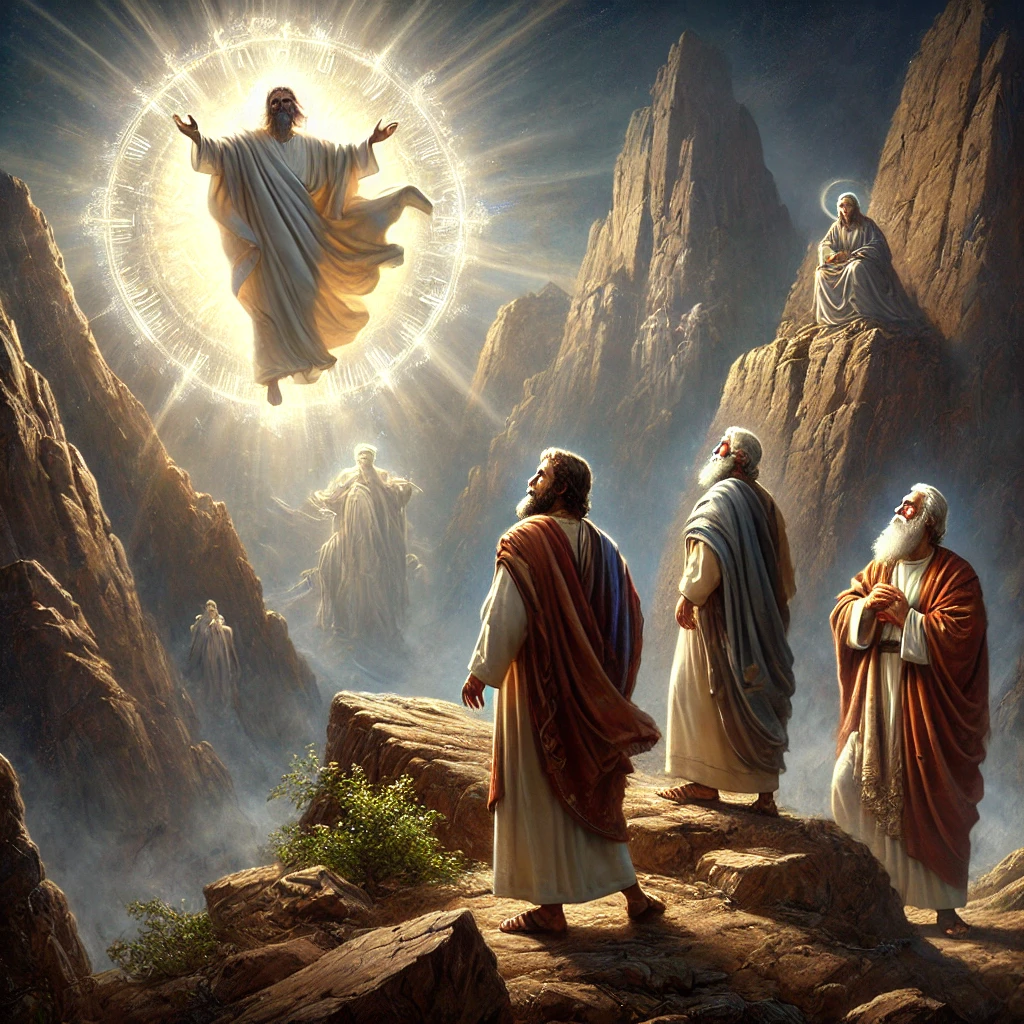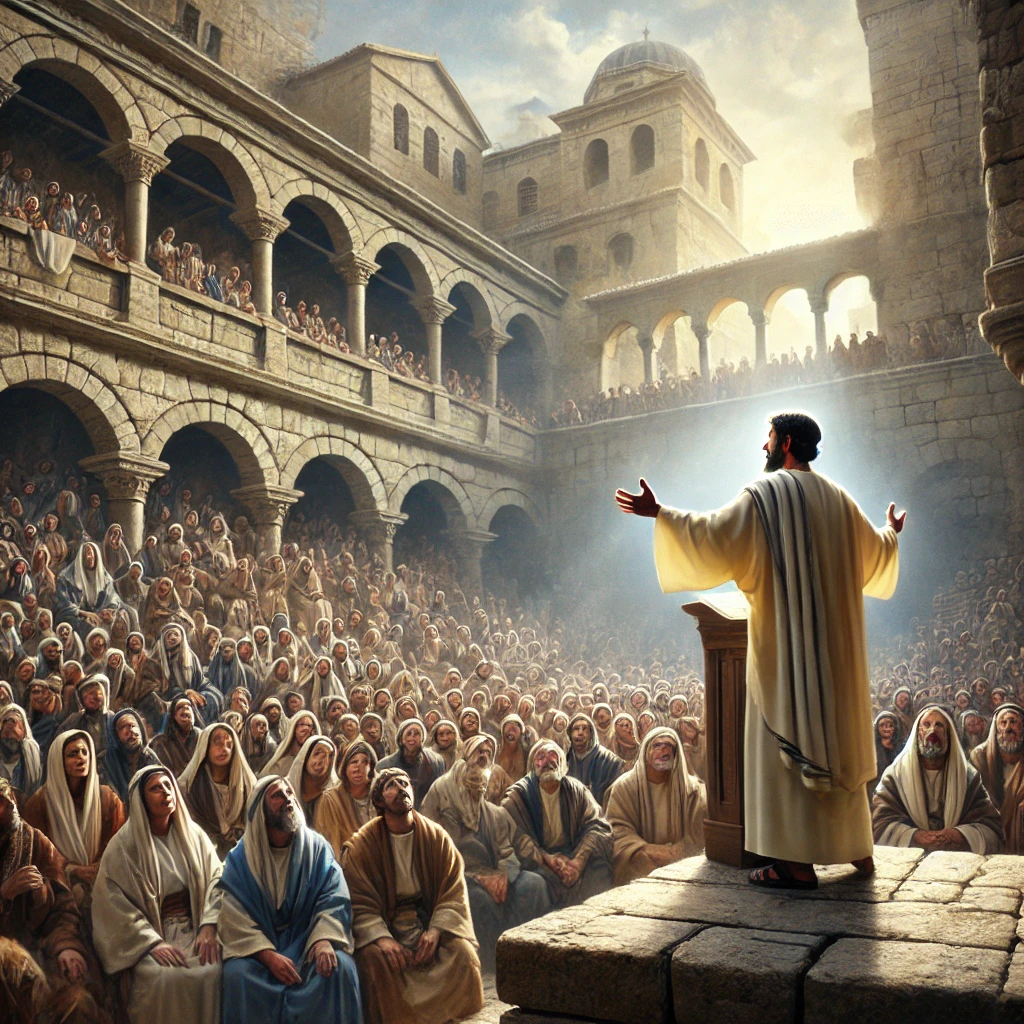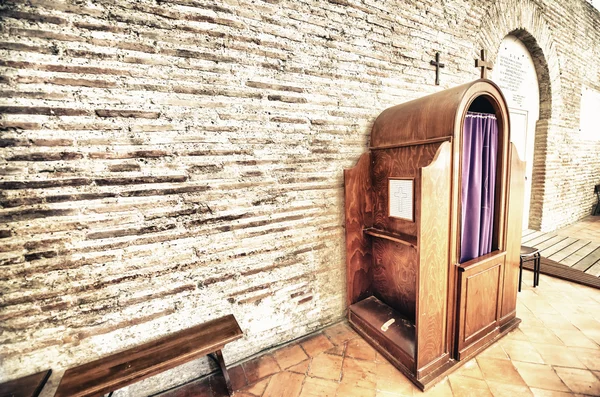Table of Contents
The Early Life of Simon Peter
Who is Peter? Simon Peter, originally known simply as Simon, was born in the village of Bethsaida, located on the northern shores of the Sea of Galilee. This region was a significant hub in ancient Judea, known for its vibrant fishing and trade activities. Peter and his brother Andrew were deeply rooted in this environment, working as fishermen to make a living. The Gospel of Matthew highlights that Peter’s father was named Jonah or John, as referenced when Jesus addresses him as “Simon Bar-Jonah.” Growing up in a region marked by a mix of cultures and religious traditions, Simon Peter was undoubtedly influenced by the diverse and dynamic environment, which later played a role in his profound spiritual transformation.
Simon Peter’s Transformation from Fisherman to Apostle
Simon Peter’s early life as a fisherman in the bustling village of Bethsaida laid the groundwork for his future role as a central figure in the early Christian Church. His upbringing in a multicultural and religiously diverse region likely contributed to his adaptability and understanding, qualities that would serve him well as he became a disciple of Jesus Christ. When Jesus called him to be a “fisher of men,” Peter’s journey from a humble fisherman to a foundational apostle began. His transformation from Simon to Peter—symbolized by the new name given to him by Jesus—marked his transition into a key leader of the early Church, playing a pivotal role in spreading the Christian faith.

The Call to Discipleship
The Life-Changing Encounter by the Sea of Galilee
Simon Peter’s life changed dramatically when Jesus approached him and his brother Andrew at the Sea of Galilee. Engaged in their fishing work, they were called by Jesus with the powerful words, “Follow me, and I will make you fishers of men.” The authority and promise in Jesus’ invitation compelled Simon Peter and Andrew to leave their nets immediately and follow Him. This pivotal moment marked the start of Simon Peter’s transformation from a fisherman into a devoted disciple. The concept of becoming “fishers of men” represented their new mission to guide people into the Kingdom of God, setting them on a path that would profoundly impact their lives and history.
Simon Peter’s Transformation and New Mission
The encounter with Jesus on the shores of the Sea of Galilee was a turning point in Simon Peter’s life. The call to leave behind his life as a fisherman and embrace a new mission as a disciple highlighted the transformative power of Jesus’ invitation. Simon Peter’s immediate response to follow Jesus, leaving his livelihood behind, demonstrated his willingness to embrace a life of spiritual leadership. The metaphor “fishers of men” perfectly captured the essence of Peter’s new role: to reach out, connect, and bring others into the fold of the faith. This pivotal moment not only changed Peter’s life but also set the foundation for his vital role in the early Christian Church.
Symbolism in Peter’s Calling
Symbolism in Simon Peter’s Transformation
The transformation of Simon Peter from a fisherman to a disciple of Jesus is laden with deep symbolism. The phrase “fishers of men” that Jesus used when calling Peter signifies a profound shift in purpose. Peter’s work would no longer be about catching fish for his livelihood, but about reaching out to people, guiding them towards faith in God. This calling represented not just a change in occupation, but also a call to a higher spiritual responsibility. The immediate and unhesitating response from Peter and his brother Andrew underscores their recognition of Jesus’ divine authority and the profound impact His words had on them. Their willingness to leave behind everything familiar highlights the deep commitment required to follow Jesus.
Embracing a New Purpose
Simon Peter’s transition from fisherman to disciple was a profound shift in purpose, not just a change in career. The phrase “fishers of men” symbolizes a move from focusing on material concerns to spiritual ones. By inviting Peter to become a “fisher of men,” Jesus offered him a role in the divine plan of salvation that went beyond his everyday work. Peter and Andrew’s immediate and unhesitant response to Jesus’ call highlights their recognition of the moment’s significance. Their willingness to leave their familiar lives and embrace a spiritually guided mission under Jesus’ direction serves as a powerful lesson in faith and devotion.

Peter’s Faith Tested: Walking on Water
Simon Peter’s Bold Step of Faith
One of the most iconic moments in Simon Peter’s life is his extraordinary experience of walking on water. During a storm on the Sea of Galilee, Peter saw Jesus walking across the water and, fueled by a bold and courageous faith, asked to join Him. Jesus invited Peter to come, prompting him to step out of the boat and walk toward Jesus on the surface of the water. This remarkable event highlights Peter’s initial act of faith, allowing him to defy the natural laws of physics as he moved toward his Master.
The Challenge of Fear and Doubt
Despite his bold start, Simon Peter’s faith began to falter when he became aware of the strong wind and turbulent waves. His focus shifted from Jesus to the storm around him, and fear took hold, causing him to sink into the water. In his desperation, Peter cried out for Jesus to save him. This episode powerfully illustrates the delicate balance between faith and doubt—Peter’s faith enabled him to perform a miraculous act, but his fear and doubt ultimately led to his momentary downfall.
The Confession of Christ in Caesarea Philippi
Simon Peter’s Declaration at Caesarea Philippi
Caesarea Philippi was a pivotal location in Simon Peter’s journey as a disciple. It was here, amid the historical and spiritual backdrop of the region, that Jesus posed a crucial question to His disciples: “Who do you say that I am?” Simon Peter stepped forward with a bold declaration, answering, “You are the Christ, the Son of the living God.” This profound statement of faith marked a significant turning point, as Jesus responded by naming Peter as the rock upon which He would build His Church. This moment underscored Peter’s pivotal role in the foundation of Christianity.
The Significance of Banias National Park
The site of this declaration, now known as Banias National Park, holds both historical and spiritual significance. The ruins of the ancient city at Caesarea Philippi stand as a testament to the profound moment when Peter’s faith was publicly affirmed by Jesus. This location serves as a powerful reminder of Peter’s key role in the establishment of the Church and the enduring impact of his confession. The area’s rich history and the significance of Peter’s declaration continue to draw attention, highlighting the lasting influence of this pivotal event.

The Transfiguration: A Glimpse of Glory
The Transfiguration: A Glimpse of Divine Glory
The Transfiguration is a monumental event in Simon Peter’s life, marking a profound revelation of Jesus’ divine nature. On a high mountain, traditionally believed to be Mount Tabor, Peter, along with James and John, witnessed an awe-inspiring transformation. Jesus’ face shone like the sun, and His clothes became dazzling white, revealing His divine glory. The appearance of Moses and Elijah, symbolizing the Law and the Prophets, further underscored the significance of the moment. This extraordinary experience offered Peter a direct glimpse of Jesus’ divine identity and the fulfillment of the Law and Prophets.
Peter’s Response and Strengthened Faith
Overwhelmed by the divine vision, Simon Peter suggested building shelters for Jesus, Moses, and Elijah, demonstrating his eagerness to honor the moment. However, his proposal was interrupted by a divine voice affirming Jesus as God’s beloved Son. This event not only confirmed Jesus’ divine identity but also served to strengthen Peter’s faith. The Transfiguration fortified Peter’s resolve, preparing him for the forthcoming challenges and deepening his understanding of Jesus’ true nature and mission.
The Denial of Jesus: A Moment of Weakness
Peter’s Denial: A Poignant Episode
Peter’s denial of Jesus is one of the most poignant episodes in his life, illustrating a moment of profound weakness. On the night of Jesus’ arrest, Peter followed Him to the high priest’s courtyard. There, he was recognized as one of Jesus’ disciples. Overcome by fear and confusion, Peter denied knowing Jesus three times, exactly as Jesus had predicted. The rooster crowed immediately after the third denial, causing Peter to realize the gravity of his actions. This realization brought him deep sorrow and regret, highlighting a stark contrast to his earlier boldness and demonstrating the human struggle with fear and failure.
The Contrast and Path to Redemption
This moment of denial serves as a powerful reminder of Peter’s vulnerability and the complexities of human faith. It contrasts sharply with his earlier courage and emphasizes the challenges of standing firm in the face of fear. Despite his moment of weakness, Peter’s story also underscores the potential for redemption and the possibility of personal growth. His subsequent repentance and restoration by Jesus illustrate the themes of forgiveness and the enduring hope for renewal.
Peter’s Restoration by Jesus
Simon Peter’s Reconciliation by the Sea of Galilee
After His resurrection, Jesus made a deliberate effort to seek out Simon Peter and restore their relationship, marking a pivotal moment in Peter’s journey. This reconciliation took place by the Sea of Galilee, where Jesus engaged Peter in a profound conversation. Jesus asked Simon Peter three times if he loved Him, providing Peter with an opportunity to affirm his love in response to his earlier threefold denial. Each affirmation was met with Jesus’ instructions to “feed my lambs” and “tend my sheep,” symbolizing Peter’s new role as a pastoral leader in the early Christian community.
The Significance of Restoration and Leadership
This threefold restoration was more than just a personal reconciliation; it was a significant turning point that solidified Simon Peter’s leadership among the apostles. The act of Jesus affirming Peter’s commitment highlighted the themes of forgiveness and renewal. By addressing Peter’s previous denials and entrusting him with the care of His followers, Jesus underscored Peter’s vital role in nurturing and guiding the early Church. This moment not only reaffirmed Peter’s mission but also served as a powerful reminder of Jesus’ grace and the transformative power of redemption.

Peter at Pentecost: The Birth of the Church
Simon Peter’s Leadership at Pentecost
Peter’s leadership was powerfully affirmed during the events of Pentecost, a defining moment in the birth of the Christian Church. On this day, Peter, filled with the Holy Spirit, boldly addressed the crowds gathered in Jerusalem. His sermon explained the profound significance of Jesus’ life, death, and resurrection, delivering a message that resonated deeply with his listeners. The impact of Peter’s speech was immense; about three thousand people were baptized that day, marking the beginning of the Church’s rapid expansion and growth.
From Fearful Disciple to Empowered Leader
This transformative event highlighted Simon Peter’s journey from a fearful disciple to a confident leader, empowered by the Holy Spirit. His ability to inspire and lead the early Christian community was a testament to the transformative power of faith. Pentecost not only fulfilled Jesus’ promise to build His Church on Peter’s confession but also underscored the profound impact of divine empowerment in overcoming fear and leading with conviction. Peter’s role in this pivotal moment exemplified the realization of his mission and the beginning of his influential leadership in the early Church.
Healing and Miracles: Peter’s Apostolic Ministry
Simon Peter’s Miraculous Acts
Peter’s ministry was characterized by miraculous acts that showcased the power of God working through him. In the Book of Acts, one notable miracle occurred at the Beautiful Gate of the temple, where Peter healed a lame man, raising him to his feet in the name of Jesus Christ. Additionally, Peter performed another profound miracle by raising Dorcas, a beloved disciple, from the dead. These acts of healing and resurrection served not only to affirm Peter’s apostolic authority but also to demonstrate Jesus’ ongoing presence and power within the early Christian community.
Affirmation of Leadership and Inspiration of Faith
These miracles played a crucial role in validating Simon Peter’s leadership and reinforcing his influence among the believers. By performing such extraordinary acts, Peter not only underscored his divine mission but also inspired faith and confidence in the early Church. His ability to perform these miracles was a powerful testament to the transformative and sustaining power of Jesus’ ministry, further solidifying Peter’s role as a central figure in the growth and establishment of Christianity.
Peter’s Epistles: Letters of Encouragement
Simon Peter’s Epistles: Insights and Teachings
Tradition attributes two epistles in the New Testament to Simon Peter, offering profound insights into his teachings and pastoral care for the early Christian communities. In 1 Peter, he addresses significant themes such as suffering, holiness, and Christian identity. Peter encourages believers to face trials with patience and hope, emphasizing the centrality of Christ in their lives. His letter provides practical guidance for Christian living, reflecting his deep concern for nurturing the faith of early Christians amidst challenges.
Warnings and Spiritual Growth in 2 Peter
In 2 Peter, the apostle shifts focus to warn against false teachers and underscores the importance of growing in Christian virtues. This epistle reflects Peter’s vigilance in safeguarding the integrity of the faith and guiding his followers through the complexities of early Christian life. His letters collectively demonstrate Peter’s dedication to the spiritual well-being of the Church, illustrating his role as a shepherd committed to guiding his flock and reinforcing their faith in difficult times.
Peter’s Martyrdom: The Ultimate Sacrifice and His Legacy in the Catholic Church
Simon Peter’s life concluded with martyrdom, a profound testament to his unwavering faith and devotion to Jesus Christ. According to Christian tradition, Peter was crucified in Rome during Emperor Nero’s reign, around 64 AD. In an act of deep humility, Peter requested to be crucified upside down, feeling unworthy to die in the same manner as his Lord. This choice reflects the transformation he underwent—from a simple fisherman to a central figure in the early Christian Church, embodying the ultimate sacrifice in service to the Gospel. Peter’s martyrdom is seen not only as the culmination of a life dedicated to spreading the Christian message but also as a powerful inspiration to generations of believers.
Simon Peter’s Connection to the Catholic Church and Apostolic Succession
Simon Peter is central to the Catholic Church, regarded as the first Pope and the foundation on which the Church is built. Catholic tradition interprets Jesus’ words, “You are Peter, and on this rock, I will build my church” (Matthew 16:18), as establishing Peter’s leadership, which continues through apostolic succession. The Church believes that the authority given to Peter by Christ has been passed down through an unbroken line of Popes, connecting the Church to its early beginnings. Peter’s martyrdom in Rome ties him to the city, which remains the heart of the Catholic Church, symbolizing the unbroken continuity of faith from Peter to the present day.

Saint Peter: The Patron of the Church
Saint Peter, recognized as the first Pope and one of Jesus’ closest apostles, holds a place of profound reverence within Christianity, particularly in the Catholic Church. Canonized as a saint, Peter’s legacy as a spiritual leader and martyr is celebrated annually on June 29th, the Feast of Saints Peter and Paul. This day honors his contributions to the Church and his ultimate sacrifice. As the “rock” upon which the Church was founded, Saint Peter’s life and martyrdom serve as enduring symbols of faith, humility, and leadership. His sainthood further cements his pivotal role in the establishment of the Church, making him a powerful intercessor and patron for believers around the world.
How useful was this post?
Click on a star to rate it!
Average rating / 5. Vote count:
No votes so far! Be the first to rate this post.
Author
-
Meet Dr. Kendall Gregory, a highly accomplished professional with a remarkable academic background and a deep passion for empowering individuals through knowledge. Dr. Gregory’s educational journey began with a Bachelor of Science degree, followed by a Doctor of Chiropractic Medicine, focusing on diagnosing and treating musculoskeletal conditions. He further expanded his expertise with a Master's degree in Oriental Medicine, specializing in acupuncture and Chinese herbology, and a Master's degree in Health Care Administration, emphasizing his dedication to improving healthcare systems. Dr. Gregory combines his extensive knowledge and practical experience to provide comprehensive and integrative healthcare solutions. Through his writings, he aims to inspire individuals to take charge of their health and make informed decisions.
View all posts






